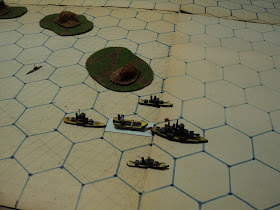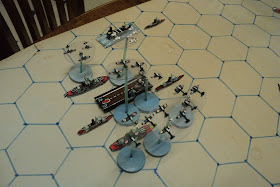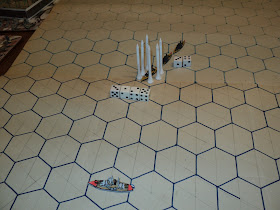 |
| Task Force 7 |
Well... not just the action. For this and subsequent postings the battle narrative will be interspersed with commentaries upon the issues that came up and possible methods of resolving them - if they seemed to need resolution. I thought I would begin with the opening passage of arms with an air attack...
 |
| The Ra'easharn objective - and whom they have to get past |
 |
| The Invasion Convoy |
 |
| Ra'esharn 'Covering Group' |
 |
| Task Force 1 - the first target for Ra'esharn aircraft. |
As the dawn of May 4, 66942 spread itself over the sunlit Laroc Sea, the Ra'esharn and Allied fleets sought each other out - the one to force a passage through to Port Fewersby for the invasion force; the other to keep that passage firmly closed.
It was the Ra'esharn 'Carrier Striking Force' that opened the ball. Scout aircraft having found to the south, heading westward, the Saabian Task Force 1, Rear Admiral Mazota ordered at once a powerful strike. All bomber aircraft from both fleet carriers - six squadrons - were ordered to obliterate the enemy group, especially the carrier. Six squadrons - eighteen 'flights' - 72 aircraft, let's call it.
 |
| The Carrier Striking Force launches its first air attack |
Before continuing, a couple of issues have already cropped up.
(1) Playing this thing solo, I felt the want of a 'proximate' cause of sending out an air attack. How was the enemy force discovered? The thought occurs that the respective fleets would send out scouting aircraft to look for them. It seems reasonable to subject this to a die roll. Call it a 50-50 proposition, although the probability of discovering anything of interest might depend on how far away is the object of the search.
(2) This brings up the matter of weather. Now, early on during the course of the Coral Sea operations, enemy fleets were hard to find anyway, but cloud cover made reconnaissance even more problematic. I thought of determining cloud cover for each quarter of the battle theatre by a die roll - a 'six' on a D6, say. This one I also let go.
(3) A third issue I will bring up here, but discuss more fully later on: how many moves between sorties by a given squadron?
 |
| Task Force One under air attack! |
As there was no shooting in the first Turn, we went straight into the moves, beginning with the launching of the air attack. I found it convenient to take the aircraft about halfway to their objectives, keeping them out of the way of moving the ships subsequently. After the moves, we move on to Turn Two - and the aircraft are moved up to their targets.
The bomber squadrons divided their attack as follows: one squadron against the cruiser SNS Gullicambe (to larboard of the carrier), three against the carrier SNS Bahamut, and two against the cruiser SNS Cockatrice. The Saabians sent up their fighter squadron - 3 flights or 12 aircraft. As the enemy priority target was obviously the carrier, the fighter took on one of the squadrons attacking it.
 |
Now, the fighter and the bomber squadron automatically cancel each other out, but there is still the combat to be resolved.
Air-air combat:
- Fighter dice rolls: 3,3,6 => bomber FP (a third of the bomber strength) shot down
- Bomber dice rolls : 1,4,5 => no effect.
Anti-aircraft fire:
- Gullicambe vs bomber Sqn: 2,4,5,6 => 1 bomber FP shot down
- 2 destroyer plus carrier vs 2 bomber squadrons: 4,4/5,6/1,2,3,5 => 1 bomber FP shot down
- Cockatrice vs 2 bomber squadrons: 3,5,6,6 => 2 bomber FPs shot down.
Bombing attacks:
- 2FP attack Gullicambe: 1,5 => no hits
- 5FP attack Bahomet: 1,2,2,2,4 => no hits
- 4FP attack Cockatrice: 2,3,5,6 => 1 hit - the 5 added to the 6 => 11FP damage!
 |
| Task Force One launches a retaliatory strike |
Task Force One had to respond. The fighters were of course unavailable, on account of their recent air action. So, in their turn, the three bomber squadrons - 36 aircraft, say - flew off to the north. It was a powerful force that awaited them.
 |
| In the distance, what TF1's aircraft will be facing... |
For their part, Task Force Seven were at the time also launching an air attack. The objective: the troop and aircraft carriers of the Ra'esharn Invasion Force.
 |
| TF7's air strike being launched. This one is going after a different objective - this one with a fighter escort. |












.jpg)






























